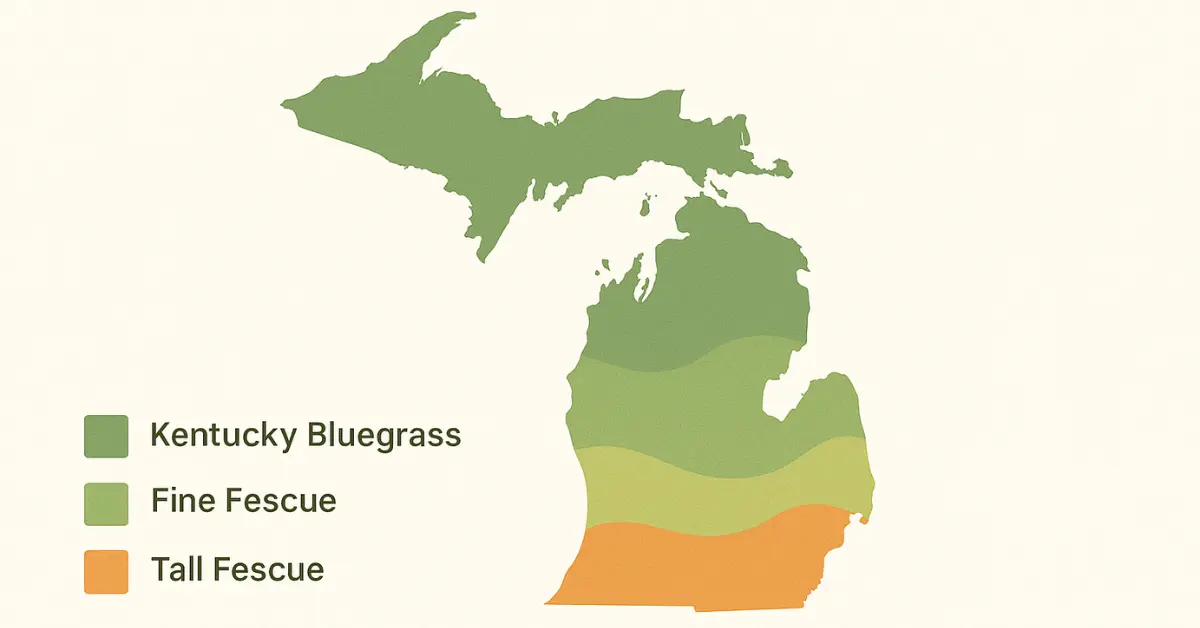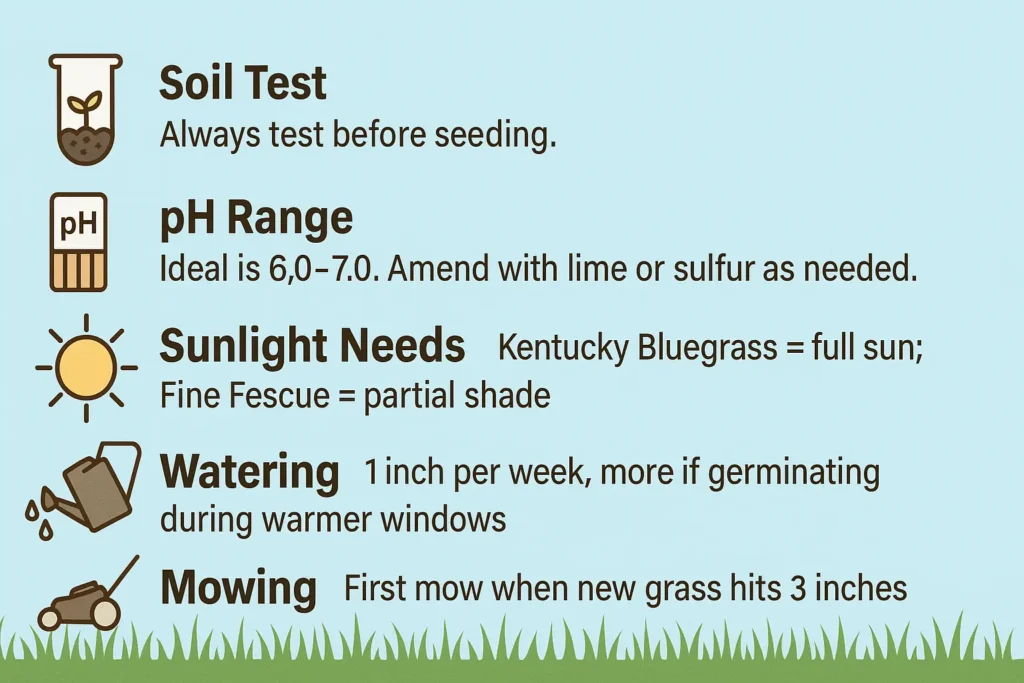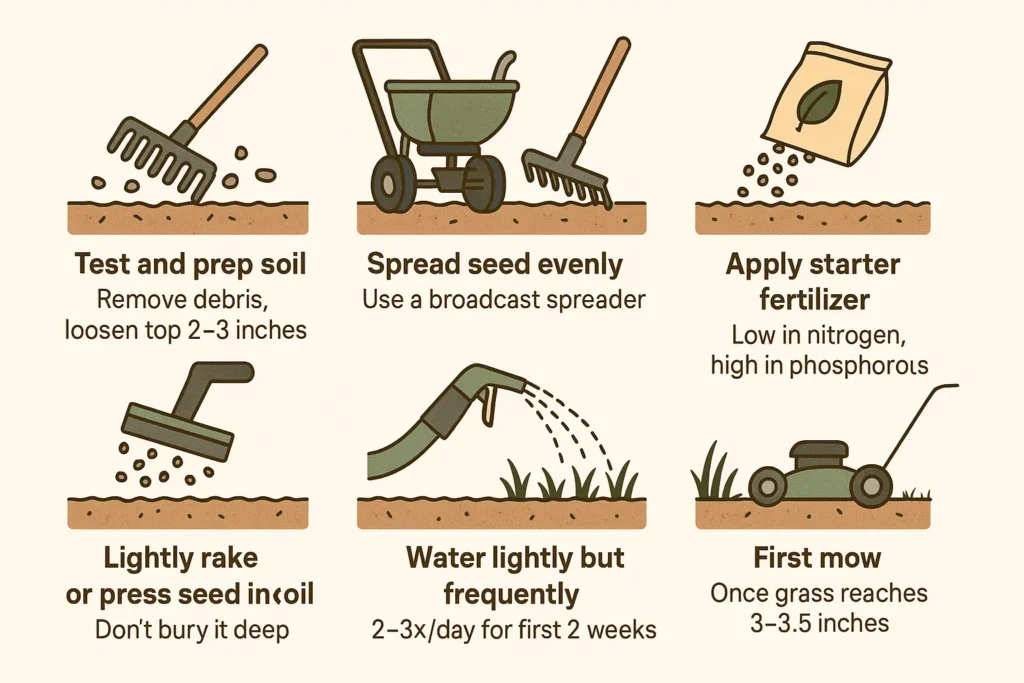When to Plant Grass Seed in Michigan: Complete Guide for Every Lawn Type

Michigan’s climate presents both opportunities and challenges when it comes to lawn care. If you’ve ever wondered when to plant grass seed in Michigan, you’re in the right place. This guide will walk you through the best planting windows, recommended seed types, hardiness zones, and step-by-step seeding techniques—tailored specifically for Michigan lawns.
Best Time to Plant Grass Seed in Michigan
The ideal time to plant grass seed in Michigan depends on the type of grass you’re using. For cool-season grasses—which dominate Michigan landscapes—the early fall is ideal. Temperatures are mild, rain is frequent, and weeds are starting to decline, giving new grass less competition. Spring is a close second, but sudden temperature swings and spring rains can be tricky.
If you’re asking when to plant grass seed in Michigan for optimal results, aim for:
- August 15 to October 1 for fall planting
- April to mid-May for spring seeding
Warm-season grasses like Bermudagrass or Zoysiagrass aren’t ideal for Michigan due to the colder winters, but we’ll get into the specifics of grass types shortly.
Michigan’s USDA Hardiness Zones & Why They Matter
Before you grab your seed bag, it’s critical to understand your hardiness zone. Michigan spans zones 4a to 6b, which helps explain why cool-season grasses perform so well here. The winters are too harsh for many warm-season varieties to survive, especially in the Upper Peninsula.
Zone: 4a–4b
Region: Northern Michigan, U.P.
Grass: Fine Fescue, Kentucky Bluegrass
Zone: 5a–5b
Region: Central MI
Grass: Tall Fescue, Ryegrass, Bluegrass
Zone: 6a–6b
Region: Southern MI
Grass: Kentucky Bluegrass, Tall Fescue
Knowing your zone ensures you choose seed that thrives in your specific microclimate. This is an important step if you want to avoid wasting time and money.
🔍 Not sure what zone you’re in? You can look up your zone here.
Best Grass Seed Types for Michigan Lawns
Let’s break down the grass types that actually thrive here. If you’re serious about figuring out when to plant grass seed in Michigan, you also need to know what to plant.
Kentucky Bluegrass
This is the go-to for many Michigan homeowners. It’s dense, cold-hardy, and self-repairing. It does require more water than others but offers a classic, lush lawn look. Ideal for full-sun areas.
Fine Fescue
If you have shady or low-maintenance areas, Fine Fescue is your friend. It tolerates poor soil and less water, and does well in Michigan’s cooler zones.
Perennial Ryegrass
Quick germination and great for overseeding. Ryegrass is often blended with Bluegrass for high-traffic lawns. It’s a cool-season grass that works well in southern and central Michigan.
Tall Fescue
With deeper roots, Tall Fescue handles drought better than Bluegrass. It thrives in southern Michigan, especially where summers are slightly hotter.
When to plant grass seed in Michigan depends on which of these types you choose. Each has a sweet spot in terms of soil temperature and timing.
Michigan Grass Seeding Schedule (By Season)
Spring:
- Seed between mid-April and mid-May
- Ensure soil temps are 50–65°F
- Prepare for possible frost and rain
Fall (Best):
- Seed between mid-August and October 1
- Fewer weeds and more stable temps
- Seed roots get time to establish before winter
Summer:
Not recommended unless you can irrigate heavily and use fast-germinating blends like Ryegrass. Hot, dry spells can ruin new seedlings.
Winter (Dormant Seeding):
Some advanced users apply dormant seeding in late fall (after the ground freezes), expecting germination in early spring. This works best with Fine Fescue.
If you’re calculating when to plant grass seed in Michigan based on temperature, always aim for soil temps above 50°F and night-time air temps consistently above freezing.
If you’re ready to dig deeper, check out our full regional breakdown and tips on the
👉 Best Time to Plant Grass Seed Guide
Soil, Water, & Sunlight Tips for Michigan Lawns
Your success depends on more than just the date you plant.
- Soil Test: Always test before seeding. Michigan soils vary widely—from sandy in the north to clay-heavy in metro Detroit.
- pH Range: Ideal is 6.0–7.0. Amend with lime or sulfur as needed.
- Sunlight Needs: Kentucky Bluegrass = full sun; Fine Fescue = partial shade
- Watering: 1 inch per week, more if germinating during warmer windows
- Mowing: First mow when new grass hits 3 inches
Knowing when to plant grass seed in Michigan means nothing if your soil is compacted, waterlogged, or totally out of balance.
Common Mistakes to Avoid
Even if you know when to plant grass seed in Michigan, it’s easy to mess it up:
- Planting too early in spring: late snow or frost can kill fresh seedlings
- Skipping soil prep: loose topsoil = better root development
- Overwatering: causes rot and weak roots
- Underwatering during germination: dries out seedlings
- Wrong seed for your area: Fine Fescue in a sunny yard = failure
Avoid these, and your odds of success skyrocket.
How to Plant Grass Seed in Michigan (Step-by-Step)
- Test and prep soil (remove debris, loosen top 2–3 inches)
- Spread seed evenly (use a broadcast spreader)
- Lightly rake or press seed into soil (don’t bury it deep)
- Apply starter fertilizer (low in nitrogen, high in phosphorus)
- Water lightly but frequently (2–3x/day for first 2 weeks)
- First mow once grass reaches 3–3.5 inches
Timing matters, but so does technique. If you’re wondering when to plant grass seed in Michigan for the best outcome, it’s usually fall—but the prep and follow-through are equally crucial.
Grass Seed by Region: What to Know
Because Michigan spans multiple zones, your seeding strategy may differ slightly by region.
Upper Peninsula
Stick with cold-hardy Fine Fescue and dormant seeding in Nov.
Northern MI
Bluegrass + Rye blends in spring or fall
Central MI
Great for all cool-season grasses—ideal in August
Southeast MI
Tall Fescue thrives here; watch for late heat
Southwest MI
Fall seeding is optimal—soil stays warm longer
Tools & Guides for Success
To make the process easier, explore the following resources available on our site:
- ✅ Grass Seed Calculator
- ✅ Lawn Fertilizer Calculator – Apply the right amount of nutrients based on lawn size and grass type
- ✅ Lawn Mowing Cost Calculator – Estimate mowing expenses by lawn size, frequency, and contractor pricing
- ✅ Lawn Care Cost Calculator – Budget for overseeding, watering, fertilizing, and more
These tools help you personalize timing and techniques beyond the general advice. Whether you’re in Grand Rapids or Marquette, local conditions matter.
Referenced Expert Guide
Looking for science-backed insights into sowing grass seed? Check out this summary from Conservation Evidence, which outlines trials, conditions, and success rates for seed establishment across climates.
This complements our advice with peer-reviewed insights and global context—especially useful if you’re experimenting with less common seed types in Michigan.
🏁 Final Thoughts: When to Plant Grass Seed in Michigan
To recap, the best time to plant grass seed in Michigan is:
- Fall (mid-August to October) for cool-season grass
- Spring (mid-April to mid-May) as a backup window
- Always know your hardiness zone
- Choose the right grass type for your conditions
So, when to plant grass seed in Michigan depends on a blend of zone, temperature, and preparation—not guesswork.
If you’re ready, grab your soil test kit, pick your seed, and bookmark this guide. Then check out our tools to fine-tune your lawn strategy.


